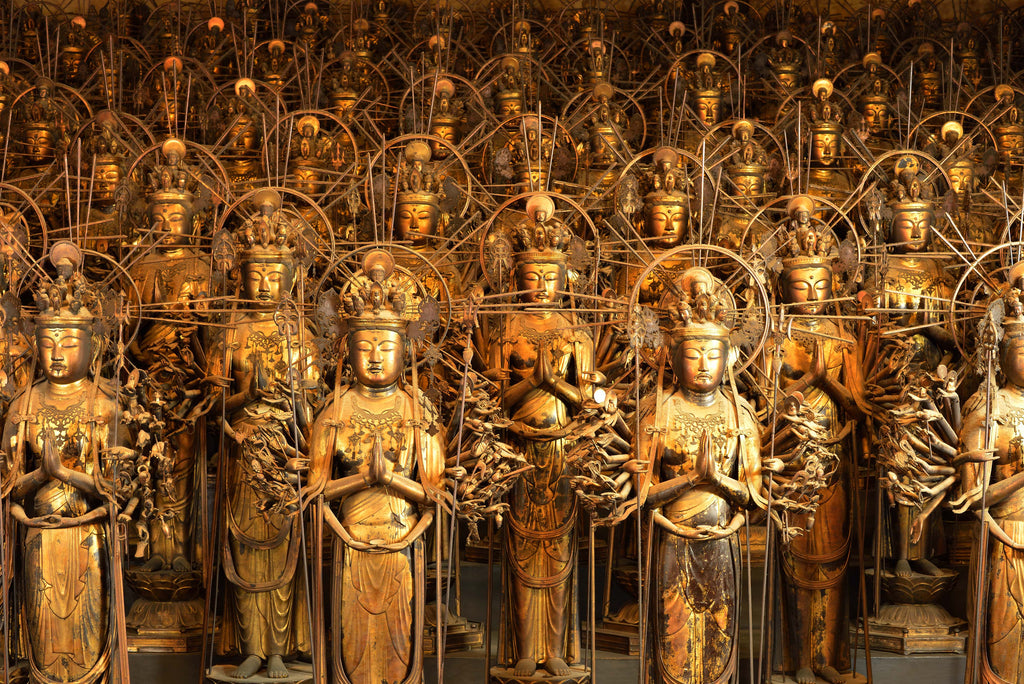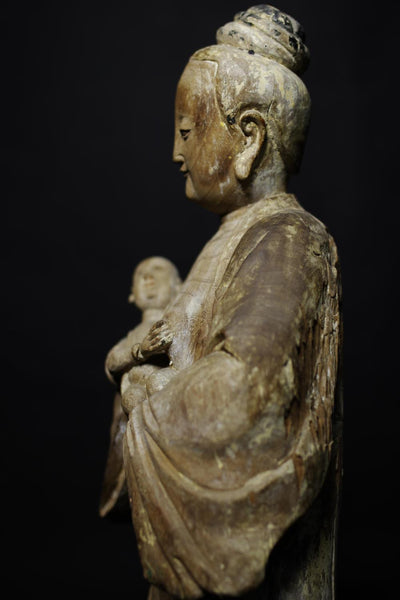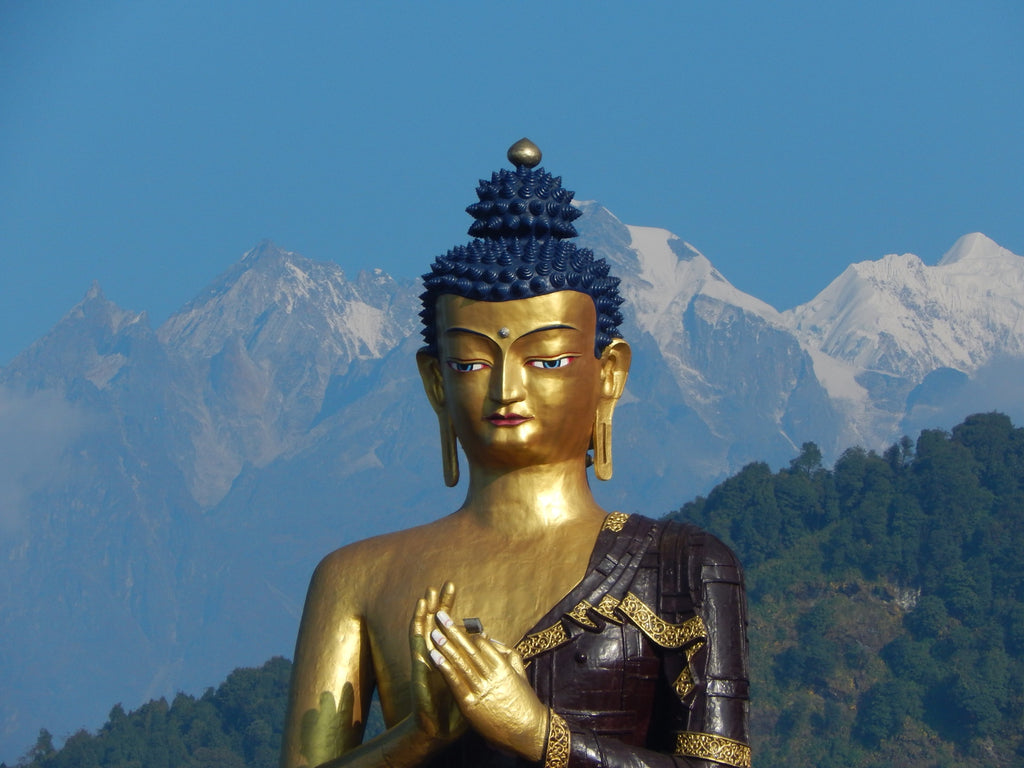Your Cart is Empty
🙏 La livraison est offerte sur tous vos achats ! 🙏

Avalokiteshvara, the Bodhisattva of Compassion, has undergone many transformations over the centuries, adopting new qualities, new names and even a different gender.
Embark with us to explore the Bodhisattva's journey through time and culture.

Enlightened compassion has a face, in Buddhist art, and a Sanskrit name: Avalokiteshvara. This great cosmic being is seated in the meditating lotus position with lowered eyelids, looking inward and downward to see the lamentations of the world.
Avalokiteshvara responds to endless circumstances by acquiring new qualities, putting on new dresses and accepting new names:
The Bodhisattva of Compassion shows us how to mold new ways of acting that allow us to skillfully help other beings. The many forms of the bodhisattva help us visualize aspects of the mind, such as enlightenment, which are imparted with extraordinary beauty.
In an exhibition devoted exclusively to Avalokiteshvara, curator Karen Lucic, art teacher and practicing Buddhist, recently looked at the great diversity of bodhisattva activity and expression in time and space. Image, Pilgrimage, Practice have brought together various representations of Avalokiteshvara paintings, thangkas, sculptures, manuscripts, mandalas, and pilgrimage memorabilia - from the depths of the Buddhist world.

The history of Avalokiteshvara dates back to the rise of Mahayana. At the beginning of the Common Era, texts mahayana such as the Lotus Sutra and the Flower Garland Sutra came from the Silk Road, Chinese artists have shaped Avalokiteshvara in culturally specific forms: sometimes male or female, but mostly genderless.

Some six hundred years after Guanyin of the South Seas, a Japanese artist from the Edo period slightly adapted this pose to create a dazzling little wooden Nyoirin Kannon with gold paint and inlays of leaves, lacquer and gilded crystal. In the exhibition, this magnificent deity, dressed in the pendant and necklace of a Bodhisattva, meditates with great grace and gentleness, her right arm bent to the point of being almost bone-free.

Looking saddened by the turmoil he sees, Kannon muse in the bodhisattva's high realm, his downcast eyes testify, his shining golden form evoking the beauty of Buddhanature. Nyoirin Kannon has a thin mustache and black goatee, suggesting that gender ambiguity had become intolerable in a medieval Japan ruled by shoguns and warlords.

The bodhisattva was a familiar figure to Nalanda, the great Buddhist monastery founded in northern India at the beginning of the common era. The books in Nalanda's well-stocked libraries praised Avalokiteshvara as Lokanatha, "Lord of the Universe, one who protects the world."Shadakshari Lokeshvara-positioned between rows of text in the Ashtasahasrika Prajnaparamita (Perfection of Wisdom) Sutra glows in opaque watercolor painted gems colors on a palm leaf
The exhibit featured five pages of similar palm leaves from a book that migrated to Tibet before Nalanda was sacked and burned by Turkish invaders in the 12th century.

During the first 1500 years of the Common Era, oases like Dunhuang in the Taklamakan Desert in western China became a cultural crossroads frequented by travelers from many civilizations: Tibetan, Indian, Uyghur, Tangout, Khotanese, Tocharian, Chinese, Caucasian. (Marco Polo was neither the first nor the only European to travel to China.)

In these harsh environments, Buddhism was an agent of change. Books and images, as well as the Buddhist practices of monasteries-universities, broke the isolation and insularity of small communities desert. The world was clearly bigger than we thought.
In return, the teachings of the Buddha on the vacuum evolved under these conditions of intensive practice. The meditating masters realized that the shunyata (emptiness), so dark to the human mind, are in fact populated with subtle energies of enlightenment, wisdom and fields of compassion filled with sublime beings.
The Prajnaparamita Sutra underwent spiritual surgery and became the Heart Sutra. In the first scene of this short but majestic sutra, Avalokiteshvara presents the teachings of shunyata to the disciple of Buddha Shariputra.

The presence of Avalokiteshvara tempers the overwhelming invocation of the Heart Sutra - "the form is exactly the void, the void is exactly the form" - with the suggestion that the empty vastness to the mind is filled with the immense compassion of the bodhisattvas.
The history of Buddhist art is therefore a sophisticated travelogue, much less sharp and linear than in Western art, much more conditional and chaotic.

As Guanyin evolved during the first millennium in China, the Bodhisattva began to show traditional feminine traits such as kindness and thoughtfulness. A 14th-century Chinese ink painting describes her as a white, melting, ghostly contemplative figure, whose drag dresses curl up on a mountain ledge.
Looking at the moon, Guanyin is almost formless in diaphanous clothes, seems to become transparent and somber, as if contemplating the void of all worldly ambition.

Jesuit missionaries, bringing their Christian evangelism to China at this time, began to circulate images of the Virgin and Child Jesus, further inspiring intercultural borrowing. A Chinese variant of Guanyin called Songzi carries a child on its hip.
In an Edo-era silk painting that stands five feet tall, Kannon, the Japanese bodhisattva, becomes motherly in a different way. The formidable celestial woman lies on the rocky shore of the legendary island of Mount Putuo, where she is believed to reside.

A fold of his bulky headdress houses a miniature Amitabha, the Buddha of Limitless Light, the higher power of the Kannon. A chubby pilgrim, like a boy, walks in the waves at his feet, his hands clasped in respect. He and others like him have come a long way to find her. It is clear that the pilgrimage is more than just "sandals on the ground". The act of research changes the researcher.

In the Himalayas, enlightenment is the great path, the way to save sentient beings safely and effectively The tantric power and direct majesty of the eleven-headed Avalokiteshvara radiates focused energy similar to that of a ray of sunshine.

The eyes show the fierce focus created by advanced tantric practices. The gilded bronze statue, now owned by the Jacques Marchais Museum of Tibetan Art, is a scaled-down replica made for pilgrims who thronged to the Jokhang temple in Lhasa.
The original, an imposing Mahakarunika, occupies the Chapel of Supreme Compassion in the temple. Mahakarunika has her own mantra of Great Compassion, which is repeated at length in the practice of Chenrezig at Mille Bras.

Mahayana practices make it a point of honor to base compassion on the desire that all beings be free from suffering. But suffering takes many forms and many resources are needed to fight it. The task can seem overwhelming to us mortals.
There is a story that resonates about how Chenrezig got his thousand arms. The bodhisattva has sworn to cleanse samsara once and for all. He made a heroic effort. He thought he did. But when he turned around, the mess returned, without any excuse.

Chenrezig was so devastated by his inability to fix things that he shattered them into a thousand pieces. That moment of turning to glass , where paralysis is the only answer, where ignorance raises its head and the suffering it causes seems medieval in its ugliness - this is also Chenrezig's dilemma. A hammer blow and the glass shatters into shards of points. What if a compassionate Bodhisattva cannot take it anymore?

The story takes an informative turn. Amitabha, the Buddha of Limitless Light, descends from his Pure Land and converts the thousand broken pieces of Chenrezig into a thousand arms (plus eleven heads, so that he can look in all directions). It is extremely informative that Amitabha gives Chenrezig a thousand tools and says, “Hey, keep going.”
Chenrezig's thousand arms are a symbolic expression of essential patience and fortitude to the bodhisattva vow. As our world prepares to collapse once again, Chenrezig becomes more than just a symbol; the bodhisattva is an absolute necessity, a guide and a refuge.

For two thousand years, art has been a powerful means of transmitting dharma. It serves that purpose today too. Our humanity and our Buddhanature are indivisible - not only spiritual, not only physical; both empty and full of life - and the great art we create is also "no two".
The heart of Buddhist practice is beyond words, but words and images help us shape and embody subtle realms of the mind and impart intuitive truths that we want to realize. It is almost impossible to imagine the Buddhist path without them.
.Comments will be approved before showing up.